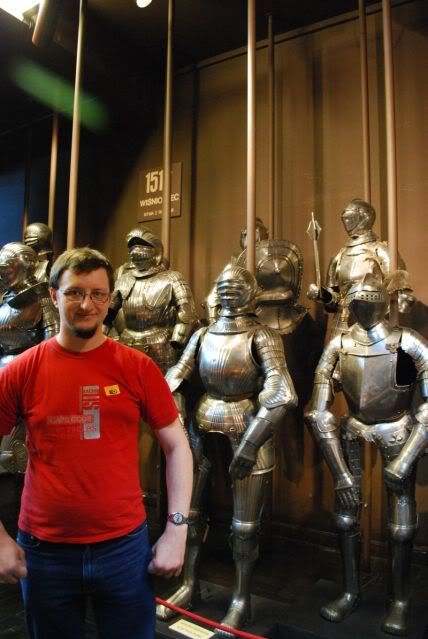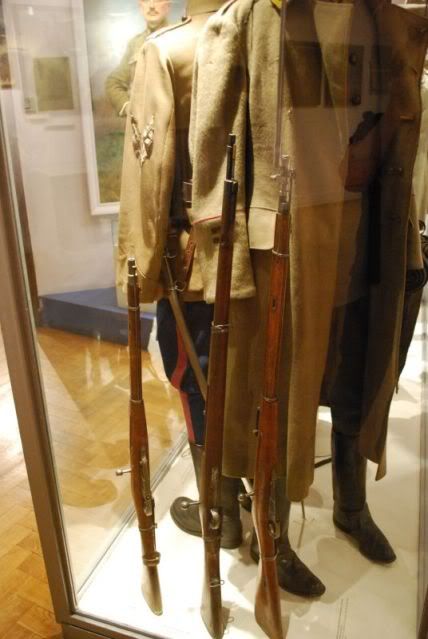Polish Army Museum
Posted: 2009-04-30 03:57am
As some of you may or may not know, me and my wife have travelled to Warsaw recently in order to take care of some important business. Well, turns out we managed to do it way faster than anticipated, and so we had some time to kill. I always wanted to visit the Polish Army Museum, and as it turned out, admission was free on Wednesdays. Really, the opportunity was too good to pass up 
I figured the photographs I made may be somewhat interesting to the folks here, especially since the museum has a lot of stuff which may be difficult to find elsewhere, and especially in the US.
Let's start from the beginning, or at least very early.

Full plate armor, in heavy use somewhere around the XVth century. Note to lack of gaps: the plates interlock with each other, creating a continous surface.

Ornamental tournament armor headpiece. I'm not sure if the owner wanted to look scary, or goof off.

Various other suits of armor - we can see the enormous variety resulting from the fact that every suit was custom made - ignore my ugly mug
The XIVth-XVth centuries were an age where Polish nationality was established, and the weaponry and armor used was very similar to typical Western designs. We'll see soon enough how those changed with the advent of practical gunpowder weapons, and wars against Eastern enemies.

Organ guns: two different designs

Hussar armor, early XVIIth century I think. Hussars were a formation of famous heavy cavalry from the gunpowder age: you can clearly see the armor does away with heavy, enclosed suits, and concentrates on protecting the vital areas.

A typical hussar on horseback. There is still controversy whether the wings served a practical purpose or were a purely ceremonial piece of attire. Most painting and the like portray hussars going to battle witht he wings on, but few documents actually concern them.

Hussar armor suits. As you can see, they vary enormously (save for the basic style) - the formation was still very much composed of nobles who purchased their own equipment.

Raittar (auxilliary infantry) armor suit. As you can clearly see, armor was not yet obsolete in the early XVIIth century, and was quite capable of stopping gunfire - twice!

Plug bayonets of various designs
Moving on: by the end of the XVIIIth century, Poland was no longer a continental superpower, and fell into disarray. Foreign powers began carving up the country, with no small help from the anarchistic nobility: this led to a period of occupation, national uprisings and creation of the "wanderer soldier" mythos.
I'll be frank and say I didn't make many pictures of the XVIIIth and XIXth century stuff: they seemed pretty generic to me, but then again, I'm a pagan who's not really all that interested in these periods.
And the exhibits were rather scarce, too
World War I: the period where Polish units fought on both sides of the frontline, realizing different concepts of gaining independence. Two most well-known units were the Polish Legion fighting for the Central Powers, and general Haller's Army in France. They came to post-war independent Poland after the war and formed the basis of the freshly created armed forces of the nation, using mostly scavenged equipment (of which a huge crapload was left on various warehouses throughought the country, including fully assembled airplanes, rifles, machine guns and artillery)

Austrian rifle grenade

A Legionairre cavalryman uniform

Cavalry carbines of various manufacturers

Vickers gun, with its wheeled carriage
More pictures once I process them. The meat of the matter is still ahead: we'll see some rarely shown equipment from the interwar period, such as the Polish designed self-loading rifle (wz. 1938), the Ur anti-armor rifle, a TS reconeissance tankette, cavalryman's gear and a pistol which the Germans couldn't help but copy.
Also, there's an open-air display of fighter jets, tanks and other armored vehicles from the postwar period.
I figured the photographs I made may be somewhat interesting to the folks here, especially since the museum has a lot of stuff which may be difficult to find elsewhere, and especially in the US.
Let's start from the beginning, or at least very early.

Full plate armor, in heavy use somewhere around the XVth century. Note to lack of gaps: the plates interlock with each other, creating a continous surface.

Ornamental tournament armor headpiece. I'm not sure if the owner wanted to look scary, or goof off.

Various other suits of armor - we can see the enormous variety resulting from the fact that every suit was custom made - ignore my ugly mug
The XIVth-XVth centuries were an age where Polish nationality was established, and the weaponry and armor used was very similar to typical Western designs. We'll see soon enough how those changed with the advent of practical gunpowder weapons, and wars against Eastern enemies.

Organ guns: two different designs

Hussar armor, early XVIIth century I think. Hussars were a formation of famous heavy cavalry from the gunpowder age: you can clearly see the armor does away with heavy, enclosed suits, and concentrates on protecting the vital areas.

A typical hussar on horseback. There is still controversy whether the wings served a practical purpose or were a purely ceremonial piece of attire. Most painting and the like portray hussars going to battle witht he wings on, but few documents actually concern them.

Hussar armor suits. As you can see, they vary enormously (save for the basic style) - the formation was still very much composed of nobles who purchased their own equipment.

Raittar (auxilliary infantry) armor suit. As you can clearly see, armor was not yet obsolete in the early XVIIth century, and was quite capable of stopping gunfire - twice!

Plug bayonets of various designs
Moving on: by the end of the XVIIIth century, Poland was no longer a continental superpower, and fell into disarray. Foreign powers began carving up the country, with no small help from the anarchistic nobility: this led to a period of occupation, national uprisings and creation of the "wanderer soldier" mythos.
I'll be frank and say I didn't make many pictures of the XVIIIth and XIXth century stuff: they seemed pretty generic to me, but then again, I'm a pagan who's not really all that interested in these periods.
And the exhibits were rather scarce, too
World War I: the period where Polish units fought on both sides of the frontline, realizing different concepts of gaining independence. Two most well-known units were the Polish Legion fighting for the Central Powers, and general Haller's Army in France. They came to post-war independent Poland after the war and formed the basis of the freshly created armed forces of the nation, using mostly scavenged equipment (of which a huge crapload was left on various warehouses throughought the country, including fully assembled airplanes, rifles, machine guns and artillery)

Austrian rifle grenade

A Legionairre cavalryman uniform

Cavalry carbines of various manufacturers

Vickers gun, with its wheeled carriage
More pictures once I process them. The meat of the matter is still ahead: we'll see some rarely shown equipment from the interwar period, such as the Polish designed self-loading rifle (wz. 1938), the Ur anti-armor rifle, a TS reconeissance tankette, cavalryman's gear and a pistol which the Germans couldn't help but copy.
Also, there's an open-air display of fighter jets, tanks and other armored vehicles from the postwar period.













